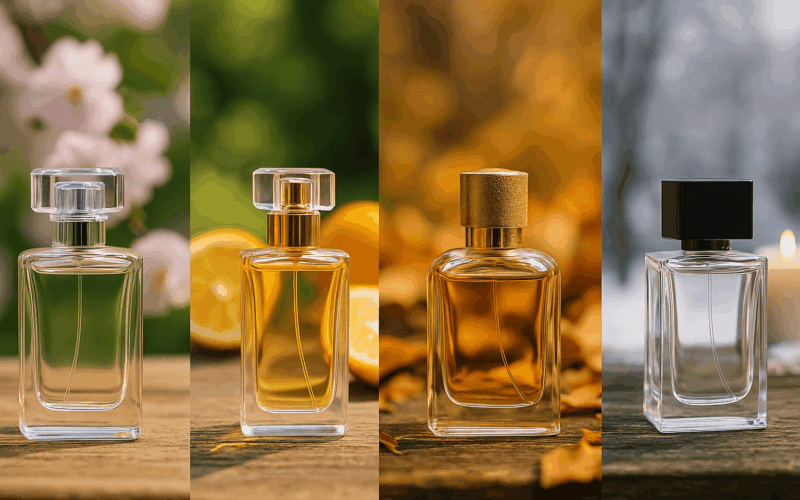Montale parfumerie reminds us that scent is personal weather. When it aligns with the temperature and the light outside, a day unfolds in harmony like an orchestra. But the wrong note can disrupt everything, like wearing a winter coat at noon in July. Matching perfume to the season isn’t magic, it’s a practice of close observation — how skin, air, and molecules behave in different environments.
Perfumers often joke that fragrances obey physics, not moon cycles. The colder the air, the slower the top notes evaporate; the higher the humidity, the heavier the base. Among seasonal compositions, Montale parfumerie stands out for its clear structure and persistence, allowing you to select perfumes that truly resonate with the atmosphere. When you understand these principles, you can build a compact, expressive fragrance wardrobe where each season has a distinct voice.
Spring: awakening and delicate detail
Spring is a return to sensitivity. After winter, skin is often dry, so light green-floral notes perform better when applied to moisturized skin. A simple trick: use unscented lotion 15 minutes before spraying—molecules cling better and last longer. Key notes that sing in April and May include lily of the valley, hyacinth, and fresh rhubarb.
Temperatures between March and May can swing from +5 to +18 °C. That means top notes may bloom or vanish unpredictably. To hold onto brightness, look for scents with a low concentration of dipropylene glycol in the base—it slows citrus evaporation without weighing the fragrance down. Spring is the time for gentle risk: layer a few drops of iris mist with green tea on your wrist. The season rewards playfulness and can bring out surprising nuances in familiar blends.
Another spring trick is applying scent to the edge of a scarf collar. Fabric breathes with your body and diffuses the sillage softly, preventing top notes from disappearing in seconds. You’ll use less spray and still create a crisp, transparent aura.
Summer: heat, speed, and spatial freedom
In summer, it’s not just the notes that matter—it’s the volatility of the formula. Hot air speeds up molecules, and even light concentrations can feel loud. Skip perfumes with 20% oil and opt for eau fraîche or eau de cologne. They evaporate quickly and create a cool breeze effect. June through August, great performers include lime, mint, sea salt, and shiso.
Experienced perfumers suggest changing application zones. Instead of wrists or neck, try hair or the inner elbow—cooler spots where scent develops slowly. For beach days or tropical weather, use body sprays with low alcohol content—sun and salt won’t dry your skin.
If you spend your days in air-conditioned offices, carry a 5 ml travel spray and reapply after lunch—most summer scents fade by then. For a boost without reapplying, spritz perfume onto your jacket lining. Fabric holds scent longer than skin and releases it gradually, like a lightly fragranced air system.
Autumn: depth, warm light, and texture
Autumn invites amber and woody stories. The air thickens, humidity drops, and notes stretch into layers. Cedar, patchouli, and dry vetiver warm up beautifully when applied to pulse points under clothing. Try the “core + trail” technique: a smoldering resin base close to the body and a gourmand mist of cocoa or rum on top.
September and October offer a unique “acoustic window”—heavy ingredients don’t feel suffocating. This is the best time to test incense, dark resins, or leather-based scents. To stay balanced, choose bases softened by honey or dried fruit. They round off harshness and add a golden hue.
Take scent breaks once a week in fall. It resets your nose and lets you rediscover layers in familiar blends. It’s also prime time for candles and diffusers—they enrich the atmosphere and extend the presence of fragrance indoors.
Winter: slow luxury and cold contrast
Winter demands weight. Cold air contracts molecules, and light scents get lost. Oriental and gourmand compositions shine here. Notes like frankincense, tonka bean, black pepper, and vanilla create a warming illusion. Apply not only to skin but to a wool scarf or coat lining—fabric warms with body heat and releases the base slowly.
Dry winter skin shortens longevity. A layer of neutral oil—like jojoba or almond—can help. It anchors the scent and thickens the trail. Winter evenings benefit from a hint of animalic musk or synthetic ambroxan—they resonate in cold air and add volume.
One trick is to use a single-resin or balsamic scent as a “base layer” under a more complex blend. Like a musical background, it builds a canvas and gives top notes structure.
Between seasons: hybrids and weather unpredictability
Seasonal transitions can feel like weather roulette—sun, wind, and rain in one day. This is where molecular fragrances or adaptable isolates come in. Their magic lies in reacting to moisture and temperature. On cool skin they whisper; in warmth they bloom.
A great example is Iso E Super, which perfumers call the “second skin” effect. Add a few drops of citrus in the morning, then layer smoky tea over it at night—you get a new personality without switching bottles. Travelers love this approach: one versatile atomizer instead of three.
If you’re planning a trip and want to keep your scents fresh, check out “How to travel with perfume: tips for transport and protection” for hacks on packing and durability.
Questions and answers about seasonal fragrance
Yes, but use it sparingly and only on fabric or hair—avoid direct skin contact to soften the sillage.
Look for wood-floral hybrids with a musky base—they adapt well to shifting temperatures and humidity.
Yes, fragrances with a balance of citrus, floral, and woods can shift their profile depending on dosage—light in summer, fuller in winter.

